Using Fractal Analysis in Modeling the Dynamics of Forest Areas and Economic Impact Assessment: Maramureș County, Romania, as a Case Study
Abstract
:1. Introduction
2. Materials and Methods
2.1. Preprocessing of Satellite Imagery
2.2. Data Analysis
3. Results
3.1. Spatio-Temporal Deforestation Rates
3.2. Spatio-Temporal Patterns of Forest Fragmentation
3.3. Relationship between Deforestation and Fragmentation/Heterogeneity
3.4. Spatio-Temporal Patterns of Economic Activity Related to Timber Harvesting
4. Discussion
5. Conclusions
Acknowledgments
Author Contributions
Conflicts of Interest
References
- Food and Agriculture Organization. Global Forest Resources Assessment 2010, Main Report, FAO Forestry Paper. Available online: http://www.fao.org/docrep/013/i1757e/i1757e.pdf (accessed on 25 September 2016).
- Pravalie, R.; Sirodoev, I.; Peptenatu, D. Detecting climate change effects on forest ecosystems in Southwestern Romania using Landsat TM NDVI data. J. Geogr. Sci. 2014, 24, 815–832. [Google Scholar] [CrossRef]
- UNCED-Agenda 21 1992, United Nations Conference on Environment & Development Rio de Janerio, Brazil, 3–14 June 1992, Chapter 11. Available online: https://sustainabledevelopment.un.org/content/documents/Agenda21.pdf (accessed on 14 August 2016).
- The UE Forest Action Plan 2007–2011. Available online: http://ec.europa.eu/agriculture/fore/publi/2007_2011/brochure_en.pdf (accessed on 14 August 2016).
- Houghton, R.A. Tropical Deforestation as a Source of Green House Gas Emissions; Mountinho, P., Schwartzman, S., Eds.; Tropical Deforestation and Climate Change, IPAM: Belem, Brazil; Environmental Defense: Washington, DC, USA, 2005; pp. 13–21. [Google Scholar]
- Peptenatu, D.; Sirodoev, I.; Pravalie, R. Quantification of the aridity process in south-western Romania. J. Environ. Health Sci. Eng. 2013, 11, 1–5. [Google Scholar] [CrossRef] [PubMed]
- Stickler, C.M.; Nepstad, D.C.; Coe, M.T.; McGrath, D.G.; Rodrigues, H.O.; Walker, W.S.; Soares-Filho, B.S.; Davidson, E.A. The potential ecological costs and cobenefits of REDD: A critical review and case study from the Amazon region. Glob. Chang. Biol. 2009, 15, 2803–2824. [Google Scholar] [CrossRef]
- Murărescu, O.; Murătoreanu, G.; Frînculeasa, M. Agrometeorological drought in the Romanian plain within the sector delimited by the valleys of the Olt and Buzău Rivers. J. Environ. Health Sci. Eng. 2014, 12, 152. [Google Scholar] [CrossRef] [PubMed]
- Thu-Ha Dang, P.; Brouwer, R.; Davidson, M. The economic costs of avoided deforestation in the developing world: A meta-analysis. J. For. Econ. 2014, 20, 1–16. [Google Scholar]
- Lawrence, D.; Vandecar, K. Effects of tropical deforestation on climate and agriculture. Nat. Clim. Chang. 2015, 5, 27–36. [Google Scholar] [CrossRef]
- Parks, N. Deforestation-related climate impacts may vary by soil. Front. Ecol. Environ. 2014, 12, 204. [Google Scholar]
- Brown, S.; Ariel, E.; Lugo, A.E. Tropical secondary forests. J. Trop. Ecol. 1990, 6, 1–32. [Google Scholar] [CrossRef]
- Salam, M.A.; Noguchi, T. Factors influencing the loss of forest cover in Bangladesh: An analysis from socioeconomic and demographic perspectives. J. For. Res. 1998, 3, 145–150. [Google Scholar] [CrossRef]
- Ickowitz, A. Shifting cultivation and forest pressure in Cameroon. Agric. Econ. 2011, 42, 207–220. [Google Scholar] [CrossRef]
- Roy, P.; Murthy, M.; Roy, A.; Kushwaha, S.; Singh, S.; Jha, C.; Behera, M.; Joshi, P.; Jagannathan, C.; Karnatak, H.; et al. Forest fragmentation in India. Curr. Sci. 2013, 105, 774–780. [Google Scholar]
- Sasaki, N. Carbon emissions due to land-use change and logging in Cambodia: A modeling approach. J. For. Res. 2006, 11, 397–403. [Google Scholar] [CrossRef]
- Turner, M.G. Landscape Ecology: The Effect of Pattern on Process. Annu. Rev. Ecol. Syst. 1989, 20, 171–197. [Google Scholar] [CrossRef]
- Gios, G. Multifunctionality and the management of Alpine forest. In The Multifunctional Role of Forest—Policies. Methods and Case Studies; EFI Proceedings 55; Cesaro, L., Gatto, P., Pettenella, D., Eds.; European Forest Institute: Joensuu, Finland, 2008; pp. 47–54. [Google Scholar]
- Zhang, J.; Alavalapati, J.R.R.; Shrestha, R.K.; Hodges, A.W. Economic impacts of closing national forests for commercial timber production in Florida and Liberty County. J. For. Econ. 2005, 10, 207–223. [Google Scholar] [CrossRef]
- Goio, I.; Gios, G.; Pollini, C. The development of forest accounting in the province of Trento (Italy). J. For. Econ. 2008, 14, 177–196. [Google Scholar] [CrossRef]
- Paletto, A.; Ferretti, F.; Cantiani, P.; De Meo, I. Multi-functional approach in forest landscape management planning: An application in Southern Italy. For. Syst. 2012, 21, 68–80. [Google Scholar] [CrossRef]
- Daniels, S.E.; Hyde, W.F.; Wear, D.N. Distributive effects of forest service attempt to maintain community stability. For. Sci. 1991, 37, 245–260. [Google Scholar]
- Petrişor, A.I. Assessment of the green infrastructure of Bucharest using Corine and urban atlas data. Urban. Archit. Constr. 2015, 6, 19–24. [Google Scholar]
- Juutinen, A.; Kosenius, A.K.; Ovaskainen, V. Estimating the benefits of recreation-oriented management in state-owned commercial forests in Finland: A choice experiment. J. For. Econ. 2014, 20, 396–412. [Google Scholar] [CrossRef]
- Andronache, I.C. Integrated fractal analysis of the morpology and dynamics of the floodplain of the river Danube. In Fractal Analysis in the Fluvial Geomorphology; Ivanov, A.V., Pozdnyakov, A.V., Eds.; University Book: Moscow, Russia, 2013; pp. 114–132. (In Russian) [Google Scholar]
- Virkkala, R. Ranges of northern forest passerines—A fractal analysis. Oikos 1993, 67, 218–226. [Google Scholar] [CrossRef]
- Sun, J.; Southworth, J. Remote sensing-based fractal analysis and scale dependence associated with forest fragmentation in an Amazon Tri-National Frontier. Remote Sens. 2013, 5, 454–472. [Google Scholar] [CrossRef]
- Eamus, D.; Chen, X.; Kelly, G.; Hutley, L.B. Root biomass and root fractal analyses of an open Eucalyptus forest in a savannah of north Australia. Aust. J. Bot. 2002, 50, 31–41. [Google Scholar] [CrossRef]
- Hansen, M.C.; Potapov, P.V.; Moore, R.; Hancher, M.; Turubanova, S.A.; Tyukavina, A.; Thau, D.; Stehman, S.V.; Goetz, S.J.; Loveland, T.R.; et al. High-resolution global maps of 21st-century forest cover change. Science 2013, 342, 850–853. [Google Scholar] [CrossRef] [PubMed]
- Roesch, F.A. A simulation of image-assisted forest monitoring for national inventories. Forests 2016, 7, 1–23. [Google Scholar] [CrossRef]
- Malek, Ž.; Scolobig, A.; Schröter, D. Understanding land cover changes in the Italian Alps and Romanian Carpathians combining remote sensing and stakeholder interviews. Land 2014, 3, 52–73. [Google Scholar] [CrossRef]
- Sousa, P.Q. Decreasing deforestation in the Southern Brazilian Amazon—The role of administrative sanctions in Mato Grosso State. Forests 2016, 7, 66. [Google Scholar] [CrossRef]
- Schneider, C.A.; Rasband, W.S.; Eliceiri, K.W. NIH Image to ImageJ: 25 years of image analysis. Nat. Methods 2012, 9, 671–675. [Google Scholar] [CrossRef] [PubMed]
- Kainz, P.; Mayrhofer-Reinhartshuber, M.; Ahammer, H. IQM: An Extensible and Portable Open Source Application for Image and Signal Analysis. PLoS ONE 2015, 10, e0116329. [Google Scholar] [CrossRef] [PubMed]
- Andronache, I.C.; Ahammer, H.; Jelinek, H.F.; Peptenatu, D.; Ciobotaru, A.M.; Draghici, C.C.; Pintilii, R.D.; Simion, A.G.; Teodorescu, C. Fractal analysis for studying the evolution of forests. Chaos Solitons Fractals 2016, 91, 310–318. [Google Scholar] [CrossRef]
- Reiss, M. IQM Plugin frac2D. 2016. Available online: https://sourceforge.net/projects/iqm-plugin-frac2d/ (accessed on 17 September 2016).
- Ahammer, H.; Mayrhofer-Reinhartshuber, M. Image pyramids for calculation of the box counting dimension. Fractals 2012, 20, 281–293. [Google Scholar] [CrossRef]
- Karperien, A.; Ahammer, H.; Jelinek, H.F. Quantitating the subtleties of microglial morphology with fractal analysis. Front. Cell. Neurosci. 2013, 7. [Google Scholar] [CrossRef] [PubMed]
- Sedjo, R.A.; Wisniewski, J.; Sample, A.V.; Kinsman, J.D. The economics of managing carbon via forestry: Assessment of existing studies. Environ. Resour. Econ. 1995, 6, 139–165. [Google Scholar] [CrossRef]
- Pintilii, R.D.; Andronache, I.C.; Simion, A.G.; Draghici, C.C.; Peptenatu, D.; Ciobotaru, A.M.; Dobrea, R.C.; Papuc, R.M. Determining forest resources evolution by fractal analysis (Suceava-Romania). Urban. Archit. Constr. 2016, 7, 31–42. [Google Scholar]
- Romanian Government Decision 46/2008, Forestry Code. Available online: http://apepaduri.gov.ro/wp-content/uploads/2014/08/Legea-nr.-46-din-2008-Codul-Silvic-.pdf (accessed on 15 September 2016).
- Gounaridis, D.; Zaimes, G.N.; Koukoulas, S. Quantifying spatio-temporal patterns of forest fragmentation in Hymettus Mountain, Greece. Comput. Environ. Urban Syst. 2014, 46, 35–44. [Google Scholar] [CrossRef]
- Peptenatu, D.; Pintilii, R.D.; Draghici, C.; Merciu, C.; Mateescu, R.D. Management of environment risk within emergency territorial systems. Case study—The influence area of the Bucharest City. J. Environ. Prot. Ecol. 2012, 13, 2360–2370. [Google Scholar]
- Pravalie, R.; Sirodoev, I.; Peptenatu, D. Changes in the forest ecosystems in areas impacted by aridization in south-western Romania. J. Environ. Health Sci. Eng. 2014, 12. [Google Scholar] [CrossRef] [PubMed]
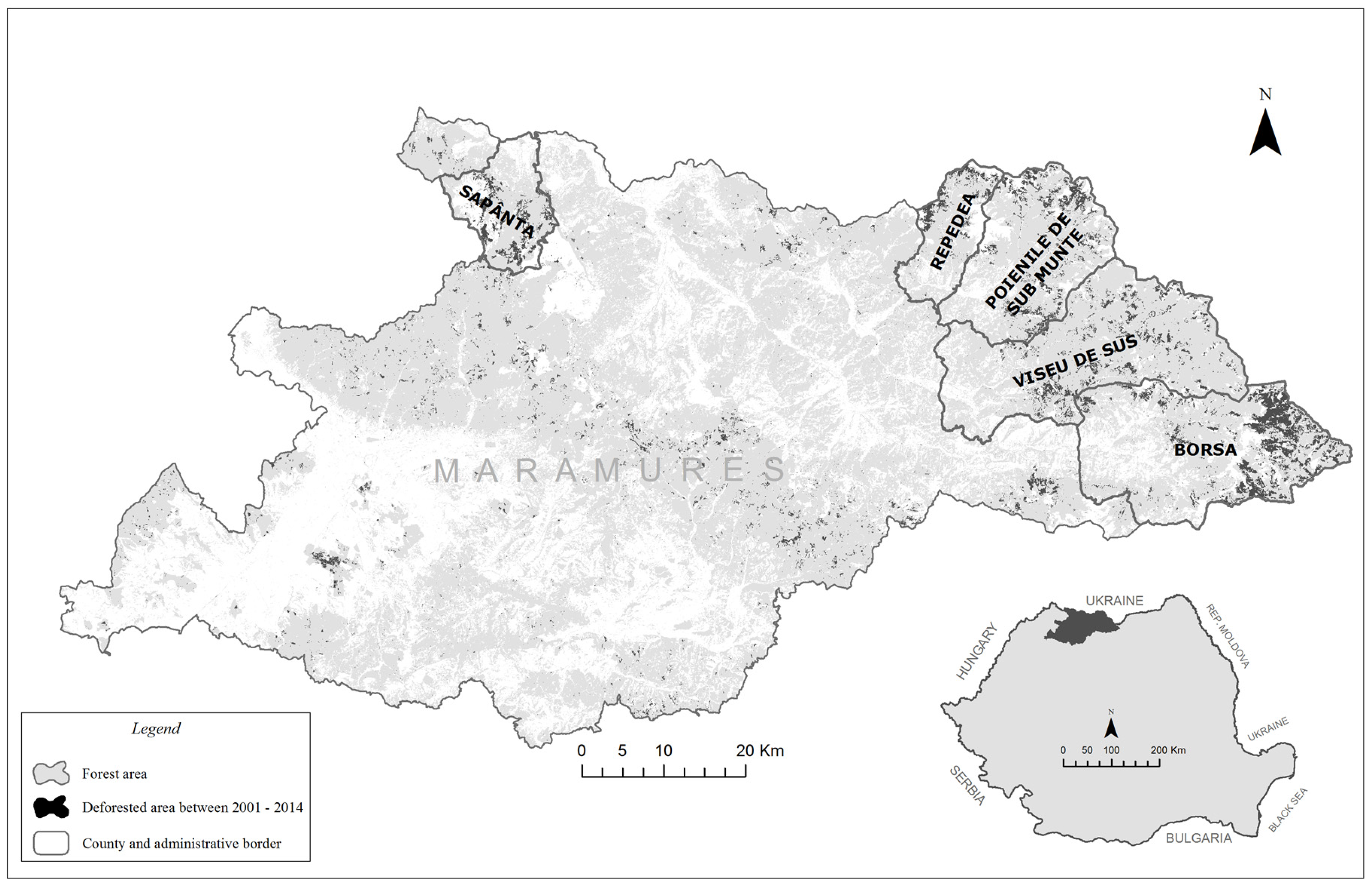

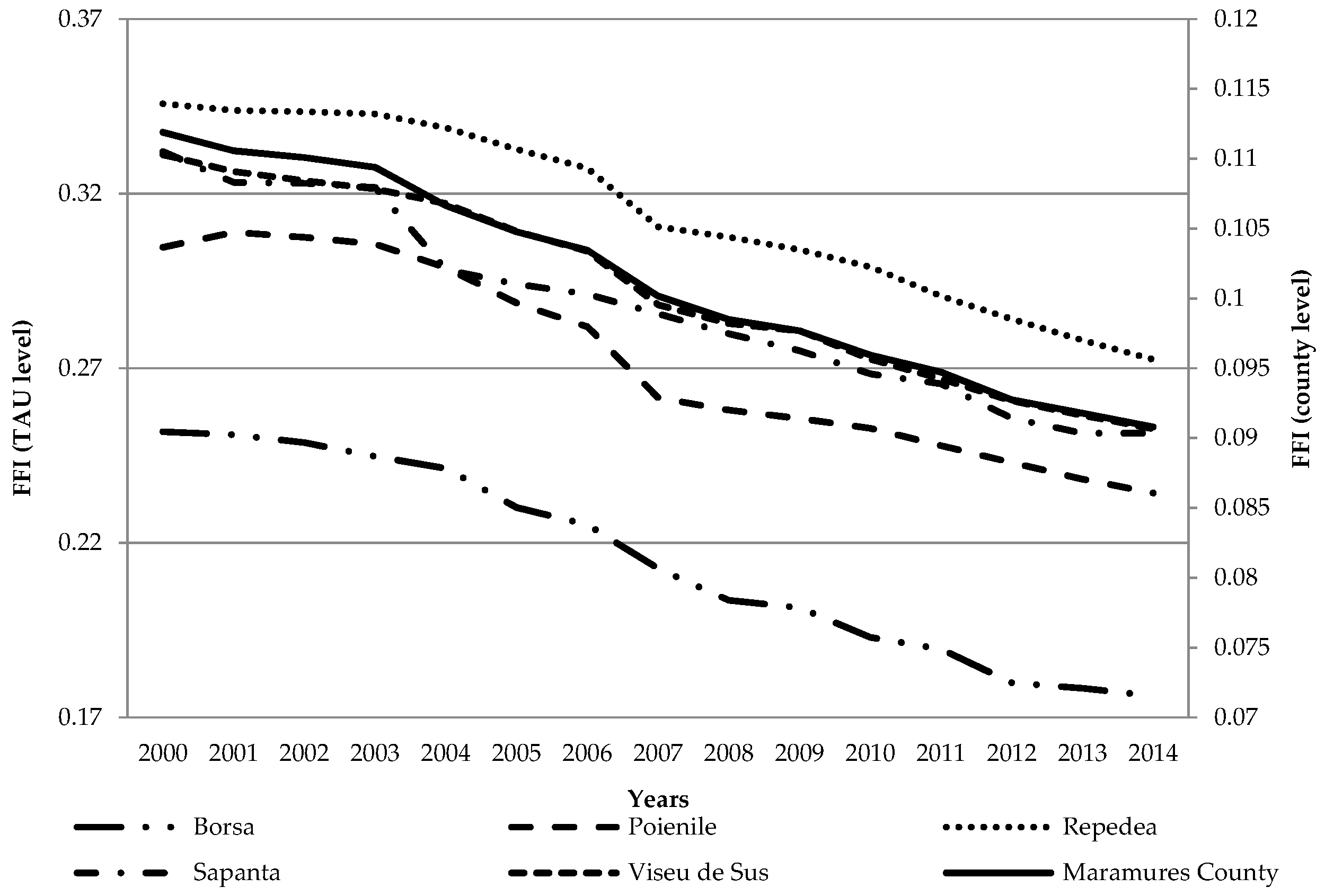
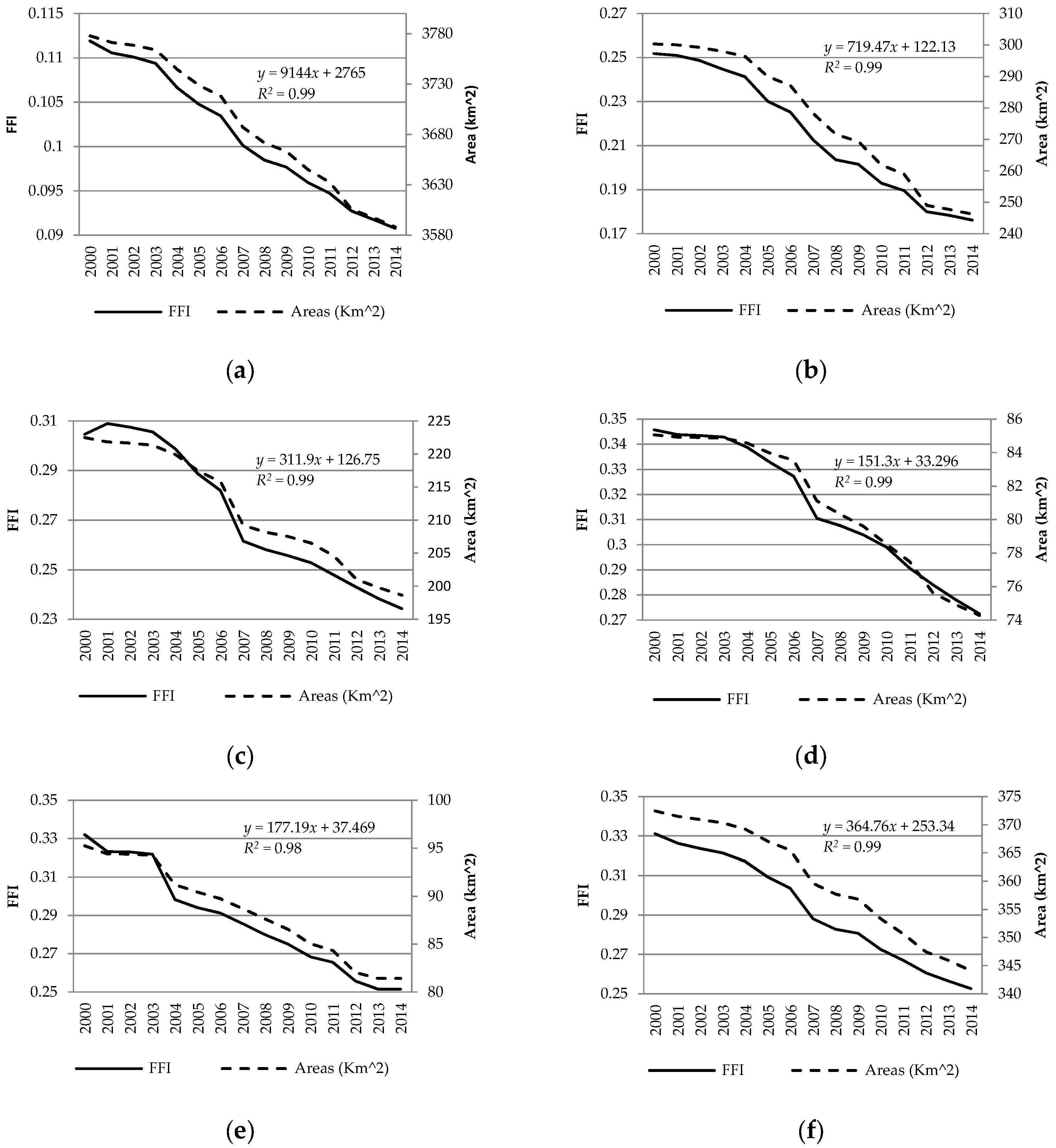


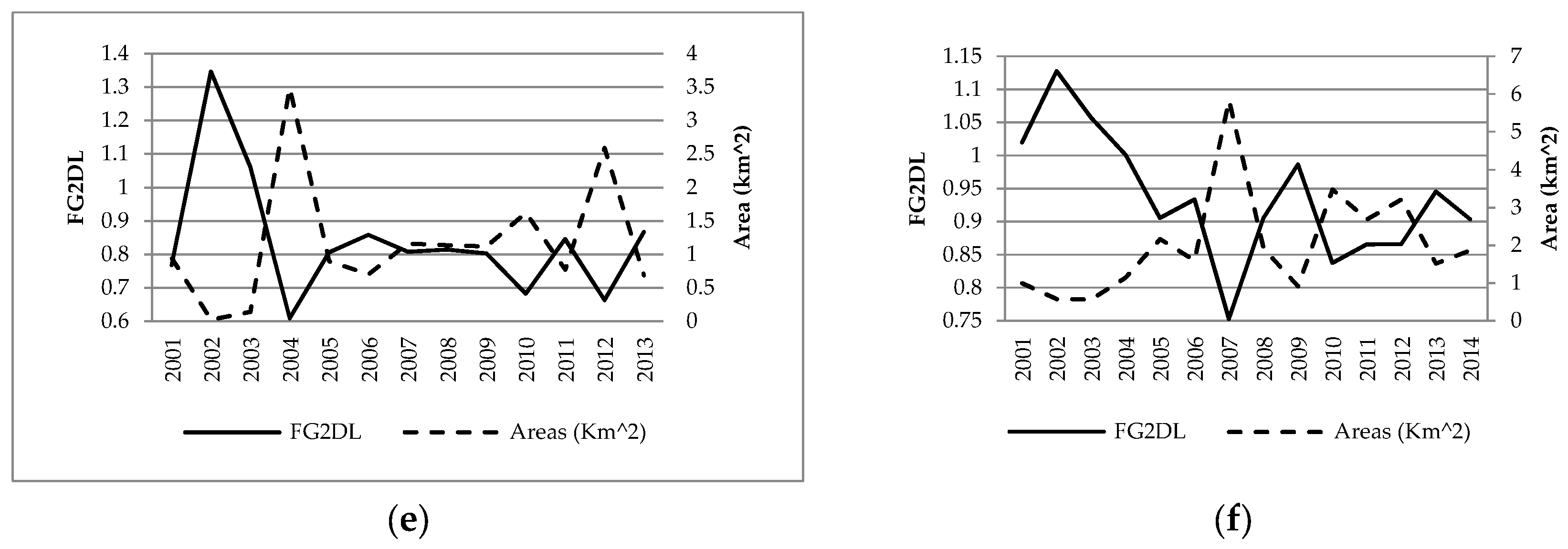
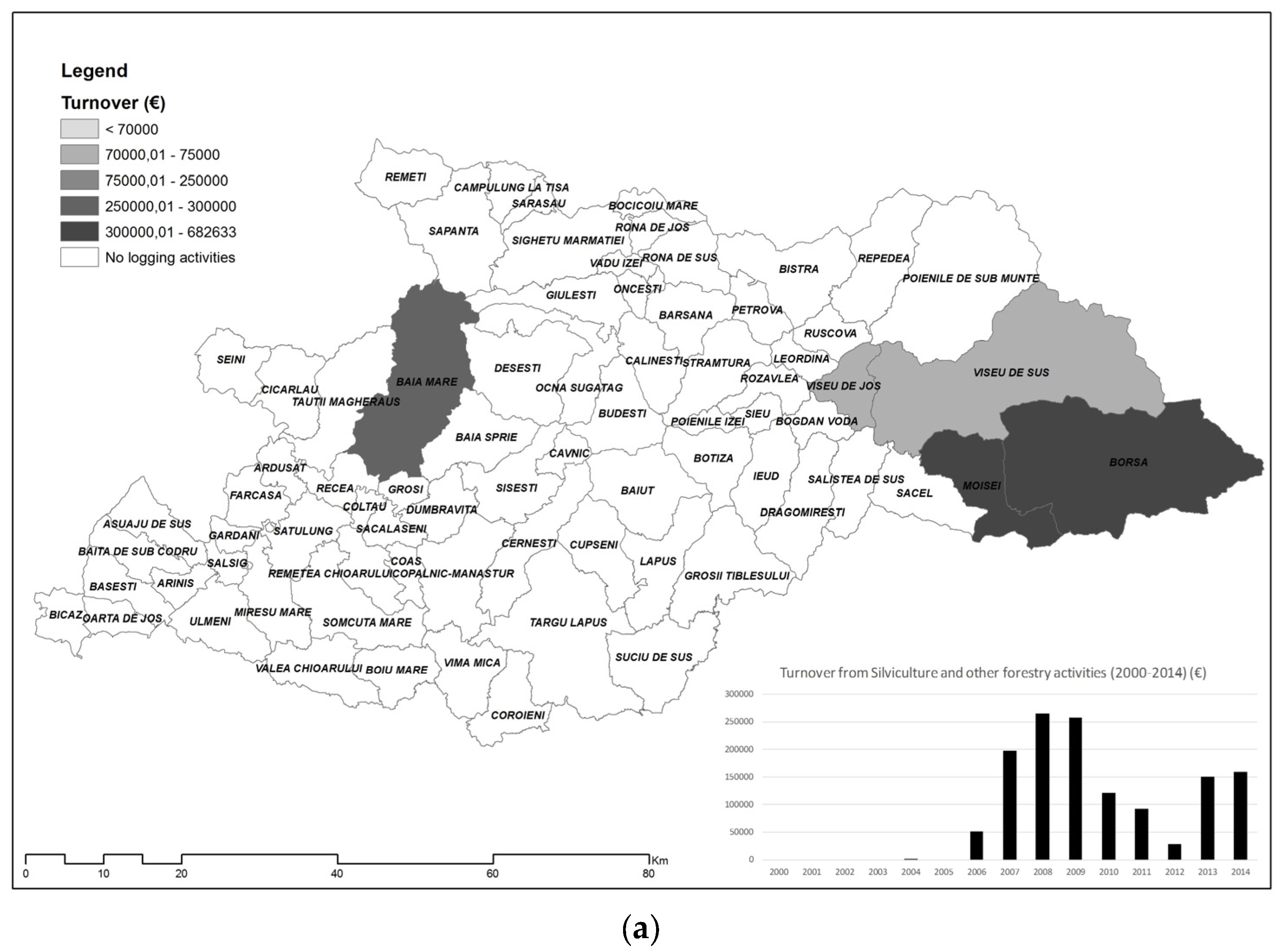

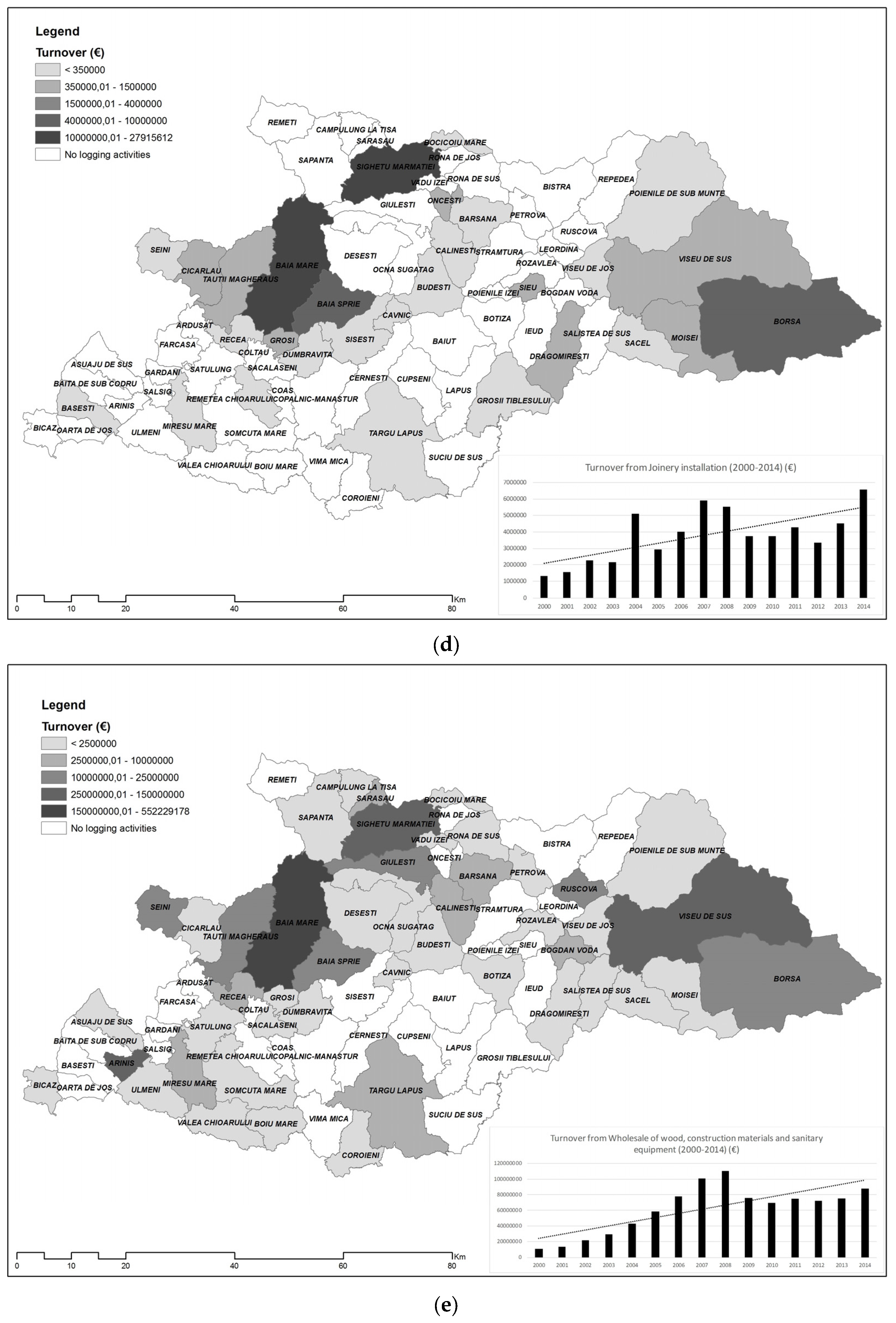
© 2017 by the authors; licensee MDPI, Basel, Switzerland. This article is an open access article distributed under the terms and conditions of the Creative Commons Attribution (CC-BY) license (http://creativecommons.org/licenses/by/4.0/).
Share and Cite
Pintilii, R.-D.; Andronache, I.; Diaconu, D.C.; Dobrea, R.C.; Zeleňáková, M.; Fensholt, R.; Peptenatu, D.; Drăghici, C.-C.; Ciobotaru, A.-M. Using Fractal Analysis in Modeling the Dynamics of Forest Areas and Economic Impact Assessment: Maramureș County, Romania, as a Case Study. Forests 2017, 8, 25. https://doi.org/10.3390/f8010025
Pintilii R-D, Andronache I, Diaconu DC, Dobrea RC, Zeleňáková M, Fensholt R, Peptenatu D, Drăghici C-C, Ciobotaru A-M. Using Fractal Analysis in Modeling the Dynamics of Forest Areas and Economic Impact Assessment: Maramureș County, Romania, as a Case Study. Forests. 2017; 8(1):25. https://doi.org/10.3390/f8010025
Chicago/Turabian StylePintilii, Radu-Daniel, Ion Andronache, Daniel Constantin Diaconu, Răzvan Cătălin Dobrea, Martina Zeleňáková, Rasmus Fensholt, Daniel Peptenatu, Cristian-Constantin Drăghici, and Ana-Maria Ciobotaru. 2017. "Using Fractal Analysis in Modeling the Dynamics of Forest Areas and Economic Impact Assessment: Maramureș County, Romania, as a Case Study" Forests 8, no. 1: 25. https://doi.org/10.3390/f8010025
APA StylePintilii, R.-D., Andronache, I., Diaconu, D. C., Dobrea, R. C., Zeleňáková, M., Fensholt, R., Peptenatu, D., Drăghici, C.-C., & Ciobotaru, A.-M. (2017). Using Fractal Analysis in Modeling the Dynamics of Forest Areas and Economic Impact Assessment: Maramureș County, Romania, as a Case Study. Forests, 8(1), 25. https://doi.org/10.3390/f8010025










